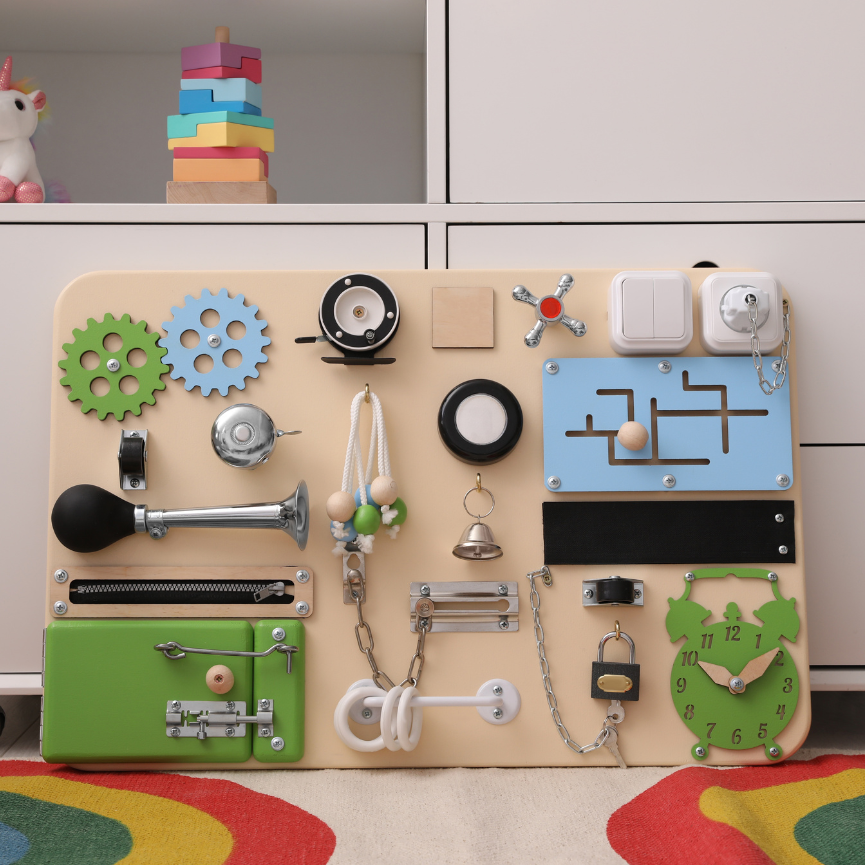
- May 13, 2024
- 105 Views
- 0 Comments
Busy Boards To Enhance Development In Children With Autism!
Children with autism can benefit from busy boards because they enable them to gradually activate their senses. They support our autistic children's learning and communication abilities while also keeping them engaged.
The boards encourage social engagement, foster expressive communication, advance cognitive development, and enhance motor growth.
We hope that Busy Boards will keep our kids playing pleasantly while also lending a helping hand to their growth and development. Children with autism can learn and explore at their own pace, thanks to it.
As parents of autistic children, you must be aware of the sensory integration challenges that children with autism spectrum disorder (ASD) have, including increased sensitivity to loud noises, bright lights, and even touch.
In addition to these problems, our children frequently display delayed communication abilities.
With poor linguistic skills, they may struggle to interpret and respond to sensory input. This sensory overload may also contribute to behavioral and information-processing issues, which can make learning challenging.
Why our children need Busy Boards
Have you ever noticed your kids becoming agitated, grumpy, or restless when they get tired of a game, certain foods, or other monotonous activities? Due to sensory abnormalities in which the information from several senses does not reach the brain, children with autism frequently exhibit hyperactivity.
These kids lack environmental stimulation, are typically not very social, and occasionally don't want to pick up basic life skills. Nonetheless, children must learn practical life skills, and playing facilitates this.
Many therapies are available to aid our children in their development of skills. Speech therapy, occupational therapy, and behavioral treatment are a few examples.
To help our kids feel comfortable and learn at their own pace, many of these activities also include play-based learning.
Using busy boards is a creative and entertaining technique to desensitize and organize the brain's assimilation of input. Such methods of sensory integration support the growth of cognitive, verbal, social, and fine motor skills as well as sensory tolerance, self-care, and home duties.
Children with autism benefit from busy boards that incorporate items like lights, Velcro, locks, hinges, and locks because they can gradually excite their senses.
The use of the boards has been shown to boost motor development, social interaction, expressive communication, and cognitive development.
Using skills to meet special needs
To give kids more sound, smell, touch, and visual sensations, the boards are safely attached with items like fidget spinners, toy race courses, calculators, bright lights, and latches.
Our students had to discuss material qualities, including elasticity, brittleness, resilience, and durability, for the project's construction engineering component. They looked at the language used to describe and measure how engineered materials react to loads and deformation.
Possible Components of Busy Boards
Devices, textures, everyday objects, sorting and math exercises, as well as items that produce cause and effect, can all be included on sensory boards.
Little children can be entertained for hours while learning by playing with materials like mirrors, lights, gears, whiteboards, magnets, or mazes. You can include things that are simple to take out and put back in to keep your board interesting and age-appropriate.
- Beads
- Buttons
- Felt
- Feathers
- Velcro
- Cotton
- Bubble wrap
- Sandpaper
- Wax paper
- Yarn
- Ribbon
- Squishy shapes
- Fake leaves or flowers
- Plastic letters or shapes
- Craft foam
- Faux fur
- Create texture with glue from the glue gun
The tactile and visual problems associated with sensory processing disorders are assisted by these boards.
Almost anything can be fastened to your board as long as it is safe and secure. To create a single board with a variety of tactile pleasures, attach the smaller coasters to a bigger board.
Things to keep in mind for a Busy Board for your Autistic child
- Keep It Simple: It's crucial to keep in mind that while designing a space with a sensory table or room, you'll want to make sure the sensory activity is the main focus.
- The remaining space in the room should be mostly uninteresting or kept apart from other play places. Children will be better able to focus on the job or craft at hand and will benefit from the reduction of overstimulation.
- Set Guidelines: Allowing kids to explore the world the way they wish to is the goal of sensory play. We, therefore, advise against too directing a youngster in how they choose to interact with the sensory objects, aside from providing general guidance for safety measures.
- Keep in Mind Sensitivities: Make your sensory area a play area for all children. We advise against ever using perfumes that can irritate skin or airways and enquiring about any allergies with parents first. In terms of using food for sensory play, we advise against it.
You should never expose kids to food allergens, and you never know whether any nearby youngsters are food insecure. We believe it is preferable to steer clear of play activities involving food for these reasons.
Have any more questions about the busy boards? We are here to support you in making learning fun for your kids! because we care for autistic children and are invested in your journey. If you have any questions, comments, recommendations, or advice, please contact us via email.
GodsOwnChild is always glad to help!



Comments - 0 comments till now